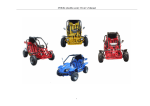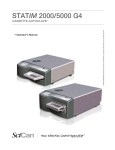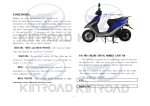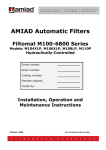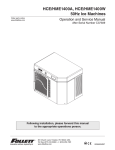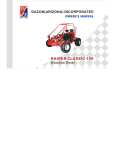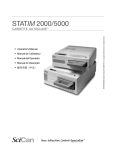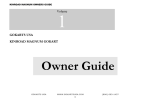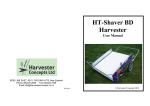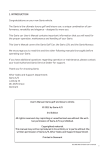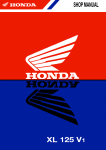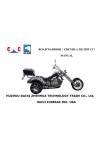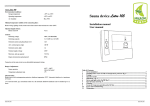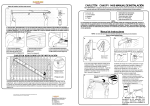Download OWNER`S MANUAL(GK150)
Transcript
Owner`s Manual Owner`s Manual Owner`s Manual OWNER`S MANUAL(GK150) 1 Owner`s Manual Owner`s Manual Owner`s Manual Owner`s Manual Owner`s Manual Limited Warranty The warranty policy applies to those cases where the new seller vehicle unloaded from its shipping container, set up and delivered by authorized dealer and under normal use and service is found to have defects in parts or workmanship under the following terms and conditions. This warranty covers the engine and engine related components for a period of 180 days. This warranty does not apply to any part that in opinion of seller was defective because of improper maintenance, improper assembly, alterations, abuse, negligence or accident. Should warranty service be required on your vehicle during the 180 days warranty period, please contact your nearest authorized KINROAD dealer for repairs. 2 Owner`s Manual Owner`s Manual Owner`s Manual Owner`s Manual What is not covered under this warranty? This warranty does not cover any seller vehicle that has been subjected to: This warranty does not cover any seller vehicle in any way so as to adversely affect its safety or reliability. b. Renting c. Disassembly, adjusting/ or repairing of the vehicle in any way so as to adversely affects its safety or reliability. d. Competition or racing The warranty does not cover loss of use of the seller vehicle, loss of time, inconvenience, or other consequential damage which includes, but is not limited to/ loss or damage to persons or property or any expense of returning any damaged units to the seller distributor or its authorized dealer. a. KINROAD has the right to make changes without notice. 3 Owner`s Manual Owner`s Manual Owner`s Manual Owner`s Manual Contents 1. FOREWORD----------------------------------------------------------------------------------------------------5 2. A FEW WORDS ABOUT SAFETY-------------------------------------------------------------------------5 3. IMPORTANT SAFETY INFORMATION------------------------------------------------------------------7 4. SAFETY LABELS---------------------------------------------------------------------------------------------11 5. ARE YOU READY TO DRIVE?--------------------------------------------------------------------------- 11 6. IS YOUR VEHICLE READY TODRIVE?----------------------------------------------------------------16 7. SAFE DRIVING PRECAUTIONS--------------------------------------------------------------------------18 8. SPECIFICATIONS--------------------------------------------------------------------------------------------23 9. OPERATION-------------------------------------------------------------------------------------------------- 26 10. SERVICE INSTRUCTIONS---------------------------------------------------------------------------------36 11. REPAIR---------------------------------------------------------------------------------------------------------44 12. PERIODICAL CHECK AND SERVICE------------------------------------------------------------------46 13. WIRING DIAGRAM -----------------------------------------------------------------------------------------47 4 Owner`s Manual Owner`s Manual Owner`s Manual Owner`s Manual Thank you for choosing our double seat BUGGY. We hope you will have fun with it. Before you start operate on the BUGGY please read through this Owner's Manual carefully as it contains important safety and maintenance information. Failure to follow the warnings contained in this manual can result in serious injuries. Be sure to follow the recommended maintenance schedule and service your vehicle accordingly. Preventive maintenance is extremely important to the longevity of your BUGGY. Beginners should drive this BUGGY in a large open area to practice handle of this BUGGY. Protective gears should be worn at all time when driving or riding this BUGGY. We hope you will have a pleasant experience with our products and thanks again for choosing KINROAD. In order to keep everyone safe, you must take responsibility for the safe operation of your BUGGY. To help you make informed decisions about safety, we have provided operating procedures and other information on labels and in this manual. This information alerts you to potential hazards that could hurt 5 Owner`s Manual Owner`s Manual Owner`s Manual Owner`s Manual you or others. It is not practical or possible to warn you about all hazards associated with operating or maintaining a BUGGY; you must use your own good judgment. You will find important safety information in a variety of forms, including; Safety Labels - On the BUGGY. symbol and one of two signal words: Safety Messages - Preceded by a safety alert WARNING, or CUATION. These signal words mean: Physical harm may result from failure to adhere to the instructions that are described within the WARNING labels. Safety Headings: such as Important Safety Reminders or Important Safety Precautions, Safety Section: such as Buggy Safety. Instruction: how to use this BUGGY correctly and safety. 6 Owner`s Manual Owner`s Manual Owner`s Manual Owner`s Manual This entire manual is filled with important safety information—please read it carefully. Your BUGGY will provide you with many years of service and pleasure providing you take responsibility for your own safety and understand the challenges you can meet while driving. There is much that you can do to protect yourself when you drive. You'll find many helpful recommendations throughout this manual. The following are a few that we consider most important. Follow the Age Recommendation It is strongly recommended that no one under the age of 16 be permitted to drive this BUGGY without adult supervision. Always Wear a Helmet It's a proven fact: helmets significantly reduce the number and severity of head injuries. Always wear an approved motorcycle helmet. We also recommend that you wear eye protection, sturdy boots, gloves, and other protective gear. 7 Owner`s Manual Owner`s Manual Owner`s Manual Owner`s Manual Drive Off-Road Only Your BUGGY is designed and manufactured for off-road use only. The tires are not made for pavement, and the BUGGY does not have turn signals and other features required for use on public roads. If you need to cross a paved or public road, get off and walk your BUGGY across. Take Time to Learn & Practice Even if you have driven other BUGGY, take time to become familiar with how this BUGGY works and handles. Practice in a safe area until you build your skills and get accustomed to this Buggy’s size and weight. Because many accidents involve inexperienced or untrained drives, we urge all drivers to take a training course approved by the BUGGY Safety Institute. Check with your dealer for more information on training courses. Be Alert for Off-Road Hazards The terrain can present a variety of challenges when you drive off-road. Continually "read" the terrain for unexpected turns, drop-offs, rocks, ruts, and other hazards. Always keep your speed low enough to allow time to see and react to hazards. 8 Owner`s Manual Owner`s Manual Owner`s Manual Owner`s Manual Drive within Your Limits Pushing limits is another major cause of BUGGY accidents. Never drive beyond your personal abilities or faster than conditions warrant. Remember that alcohol, drugs, fatigue, and inattention can significantly reduce your ability to make good judgments and drive safely. Don't Drink and Drive Alcohol and driving don't mix. Even one drink can reduce your ability to respond to changing conditions, and your reaction time gets worse with every additional drink. So don't drink and drive, and don't let your friends drink and drive either. Do not operate this BUGGY at night. Dark vision can greatly reduce a driver's visibility and judgment. So driving at night is dangerous and can increase possibility for accident. Never run your BUGGY indoors. The exhaust from the engine contains a tasteless, odorless and poisonous gas called carbon monoxide. 9 Owner`s Manual Owner`s Manual Owner`s Manual Owner`s Manual Keep away from moving parts of the BUGGY The operator of the BUGGY should never place their hands or other parts of their body near any moving part of the BUGGY. Failure to adhere to this warning will cause physical harm to your body. Skidding or Sliding The terrain surface can be a major factor affecting turns. Skidding a turn is more likely to occur on slippery surfaces such as snow, ice, mud and loose gravel. If you skid on ice, you may lose all directional control. To avoid skidding on slippery terrain, keep your speed low and drive carefully. This section presents some of the most important information and recommendations to help you drive your BUGGY safely. Please take a few moments to read these pages. 10 Owner`s Manual Owner`s Manual Owner`s Manual The labels should be considered permanent parts of the BUGGY. If a label comes off or becomes hard to read, contact your dealer for warning labels replacements. Before each drive you need to make sure you and your BUGGY are both ready to drive. To help get you prepared, this section discusses how to evaluate your driving readiness, what items you should check on your BUGGY, and adjustments to make for your comfort, convenience, or safety. Before you drive your BUGGY for the first time, we urge you to: • Read this owner's manual and the labels on your BUGGY carefully • Make sure you understand all the safety messages. • Know how to operate all the controls. 11 Owner`s Manual Owner`s Manual Owner`s Manual Owner`s Manual Owner`s Manual • Have adult present if under 16 years old. Before each drive, be sure: • You feel well and are in good physical and mental condition. • You are wearing an approved motorcycle helmet (with chin strap tightened securely), eye protection, and other protective clothing. • You don't have any alcohol or drugs in your body system. Protective Apparel For your safety, we strongly recommend that you always wear an approved motorcycle helmet, eye protection, boots, gloves, long pants, and long-sleeved shirt or jacket whenever you drive. Although complete protection is not possible, wearing proper gears can reduce the chance of injury when you drive. The following suggestions will help you choose the proper driving gears. Helmets and Eyes Protection Your helmet is your most important piece of driving gear because it offers the best protection against head 12 Owner`s Manual Owner`s Manual Owner`s Manual Owner`s Manual injuries. A helmet should fit your head comfortably and securely. An open-face helmet offers some protection, but a full-face helmet offers more. Regardless of the style, look for a DOT (Department of Transportation) sticker in any helmet you buy. Always wear a face shield or goggles to protect your eyes and help your vision. Additional Driving Gears In addition to a helmet and eye protection, we also recommend: • Sturdy off-road motorcycle boots to help protect your feet, ankles, and lower legs. • Off-road motorcycle gloves to help protect your hands. • Driving pants with knee and hip pads, a driving jersey with padded elbows, and a chest and shoulder 13 Owner`s Manual Owner`s Manual Owner`s Manual Owner`s Manual protector. Driver Training Developing your driving skills is an on-going process. Even if you have driven other Buggies, take time to become familiar with how this BUGGY works and handles. Practice driving the BUGGY in a safe area to build your skills. Do not drive in rough terrain until you get accustomed to the BUGGY's controls, and feel comfortable with its size and weight. Age Recommendation It is strongly recommended that no one under the age of 16 be permitted to operate this BUGGY without adult supervision. 14 Owner`s Manual Owner`s Manual Owner`s Manual Owner`s Manual No Alcohol or Drugs Alcohol, drugs and Buggies don't mix. Even a small amount of alcohol can impair your ability to operate a BUGGY safely. Likewise, drugs---even if prescribed by a physician---can be dangerous while operating a BUGGY. Consult your doctor to be sure it is safe to operate a vehicle after taking medication. 15 Owner`s Manual Owner`s Manual Owner`s Manual Owner`s Manual Before each drive, it is important to inspect your BUGGY and make sure any problems you find are corrected. A pre-drive inspection is a must, not only for safety, but because having a breakdown, or even a flat tire, can be a major inconvenience. If your BUGGY has overturned or has been involved in a collision, do not drive it until your BUGGY has Pre-drive Inspection Check the following items before you get on the BUGGY: ● Engine Oil: Check the level and add oil if needed. Check for leaks. ● Fuel: Check the level and add fuel if needed. Also make sure the fuel filling cap is securely fastened. Check for leaks. 16 Owner`s Manual Owner`s Manual Owner`s Manual Owner`s Manual Tires: Use a gauge to check the air pressure. Adjust if needed. Also look for signs of damages or excessive wear. ● Nuts & Bolts: Check the wheels to see that the axle nuts are tightened. Use a wrench to make sure all accessible nuts, bolts, and fasteners are tight. ● Underbody & Exhaust System: Check for and remove any dirt, vegetation or other debris that could be fire hazard or interfere with the proper operation of the BUGGY. ● Air Cleaner Housing Drain Tube: Check for carbon deposits in the drain tube. If necessary, clean the tube and check the air cleaner housing. ● Leaks, Loose Parts: Walk around your BUGGY and look for anything that appears unusual, such as a leak or loose cable. ● Lights: Make sure the headlight, brake light and taillight are working properly. ● Throttle: Check the free play and adjust if needed. Press the throttle to make sure it moves smoothly without sticking, and snaps back automatically when it is released. ● Brakes: Press the rear brake pedal several times, check for proper brake pedal free play. Make sure there is no brake fluid leakage. ● Engine Stop Button: When engine is running, press and hold the Engine Stop Button for two seconds. Make sure the engine stops. ● 17 Owner`s Manual Owner`s Manual Owner`s Manual Owner`s Manual ● Steering Wheel: Check that the wheels turn properly as you turn the steering wheel. ● Cable: Check the cable housing for wear. Check the fittings for looseness. Replace or tighten as needed. Off-Road Use Only Your BUGGY and its tires are designed and manufactured for off-road use only, not for pavement. Driving on pavement can affect handling and control. You should not drive your BUGGY on pavement. 18 Owner`s Manual Owner`s Manual Owner`s Manual Owner`s Manual When driving off-road, also remember to always obey local off-road driving laws and regulations. Obtain permission to drive on private property. Avoid posted areas and obey "no trespassing" signs. You should never drive your BUGGY on public streets, roads or highways, even if they are not paved. Drivers of street vehicles may have difficulty seeing and avoiding you, which could lead to a collision. In many states it is illegal to operate Buggies on public streets, roads and highways. Keep Hands and Feet on Controls Always keep both hands on the steering wheel and both feet on the foot controls when driving your BUGGY. It is important to maintain your balance and to control the BUGGY. Removing hands or foot away from the controls can reduce your ability to react control of the BUGGY. 19 Owner`s Manual Owner`s Manual Owner`s Manual Owner`s Manual Control Speed Driving at excessive speed increases the chance of an accident. In choosing a proper speed, you need to consider the capability of your BUGGY, the terrain, visibility and other operating conditions, plus your 20 Owner`s Manual Owner`s Manual Owner`s Manual Owner`s Manual Use Care on Unfamiliar or Rough Terrain Before driving in a new area, always check the terrain thoroughly. Don't drive fast on unfamiliar terrain or when visibility is limited. (It’s sometimes difficult to see obstructions like hidden rocks, bumps, or holes in time to react.) Never drive past the limit of visibility. Maintain a safe distance between your BUGGY and other off-road vehicles. Always exercise caution and use extra care on rough, slippery and loose terrain. 21 Owner`s Manual Owner`s Manual Owner`s Manual Owner`s Manual Do Not Perform Stunts You should always operate your BUGGY in a safe and reasonable manner. When driving, always keep all four wheels on the ground. 22 Owner`s Manual Owner`s Manual Owner`s Manual DIMENSIONS Overall Length Overall Width Overall Height Wheelbase double-seat 2330mm/2495 mm (XT150GK-7) 1480mm 1480mm 1580mm ENGINE Model Type Engine Capacity 1P57QMJ SINGLE EYLINDER,4-Strokes, Air Cool 149.6 cc Bore x Stroke Compression Ratio Max Power Standard Power Max Torque 57.4×57.8 9.5:1 6.5/7500 kW/rpm 6.0/7000 kW/rpm 9.8/5000 N.m/rpm 23 Owner`s Manual Owner`s Manual Owner`s Manual Owner`s Manual Idle Speed 1500+/-100rpm Min Fuel Consumption Fuel Type Lubricate Oil Displacement Ignition Starting Spark Plug Clutch Generator Carburetor Lubrication Air Cleaner Transmission Gear-shifting ≤2.8(1/100km) SAE 90# or above (unleaded) SAE 10W/30SF 149.6ml C.D.I. Electric A7RTC Automatic, Centrifugal, Dry, Shoe type Outer Rotor, Flywheel Vacuum Film type Pressure & Splash Foam Element, Filtration type Automatic (C.V.T system) Automatic, Centrifugal 24 Owner`s Manual Owner`s Manual Primary Transmission Ratio Owner`s Manual Owner`s Manual Reduction Ratio Cooling Net Weight 2.800(42/15) 3.076(40/13) Air Cool 28.0 kg CAPACITIES Fuel tank Starting Climbing Top speed 9.0L Electric 250 60km/h CHASSIS Brake system Hydraulic disc, left foot control TIRE PRESSURE Front Rear 194kpa/175kpa 222kpa/200kpa 25 Owner`s Manual Owner`s Manual Owner`s Manual WEIGHT Net Weight Owner`s Manual Owner`s Manual 241kg A. Operation controls WARNING - Do not attempt to start or operate the engine until completely familiar with the location and use of each control necessary to operate this vehicle. The operator must know how to stop this machine before starting and driving it. a. Throttle The right foot pedal is the throttle that controls the BUGGY speed. As the engine speed is above idle, the clutch automatically engages and moves the vehicle forward. To disengage the clutch at any time, allow the throttle to return to the idle position. 26 Owner`s Manual Owner`s Manual Owner`s Manual Owner`s Manual b. Brake The brake is located on the left side of the vehicle. Applying pressure to the pedal draws the brake calipers around the brake pumps (one at the rear wheel, two at the front wheel) and slows or stops the kart. c. Key Switch Insert the key into the key switch, turn the key clockwise, and release the key when the engine starts. The engine will warm up within 5 minutes and the engine choke would close automatically and operate at formal RPM (Warning: Don't crank starter more than 5 seconds 27 Owner`s Manual Owner`s Manual Owner`s Manual Owner`s Manual at one time). d. Engine Stop Button Important-----stop button test. Before driving this vehicle, test the Engine Stop Button to assure that it is operating properly. With the engine running, move the Stop Button to the “OFF” position. a. Check for Engine Oil Level. Check for leaks, add oil if required. b. Check for Fuel Level. Add fuel if necessary and do not overfill. Check for leaks. c. Check for Brakes. Depress the rear brake pedal several times, and then check for proper brake pedal 28 Owner`s Manual Owner`s Manual Owner`s Manual Owner`s Manual free play. Make sure there is no brake fluid leakage. Adjust if necessary. d. Check Tires. Check tires condition and pressure. The pressure on both Front and Rear tire is 15kPa and 20kPa. e. Check Drive Chain. Check for chain's condition and tension. Lubricate if necessary. f. Check Throttle. Check for smooth operation. Assure throttle "snaps" back to idle. g. Check Engine Stop Button. Perform engine stop button test. Repair if necessary. h. Check all Nuts, Bolts, and fasteners. Check wheels to see that all axle nuts are tightened properly. Check and tighten if necessary all other fasteners to specified condition. i. Check Roll Cage Bar. Ensure all protective roll cage bar are in place before operating the BUGGY. j. Check Brake Light. Check for proper operation. k. Check Wheels. Check for tightness of wheel nuts and axle nuts; check that axle nuts are secured by cotter pins. l. Check Steering. Check for free operation for any unusual looseness in any area. 29 Owner`s Manual Owner`s Manual Owner`s Manual 30 Owner`s Manual Owner`s Manual Owner`s Manual Owner`s Manual C. Preparation Before Starting The Engine (1) Check the engine fasteners before starting. (2) Fill in fuel, lubrication oil and anticorrosive antifreeze as specified. Oil Capacity: Crankcase: 0.8-1.0 L; Transmission box: 0.11L 31 Owner`s Manual Owner`s Manual Owner`s Manual Owner`s Manual Owner`s Manual D. Passengers The vehicle allows for two riders only for the double seat unit and one rider only for the single seat unit. Combine maximum weight of driver and the passenger for the double seat unit should not exceed 180kg or 400lbs. Combine maximum weight of driver and the passenger for the single seat unit should not exceed 90kg or 200 lbs E. Seat Adjustment The seat must always be securely fastened in the position which best affords the operator control of the foot pedals, steering wheel, and the engine stop button. a. Pull seat adjustment handle upward to disengage seat slide. 32 Owner`s Manual Owner`s Manual Owner`s Manual Owner`s Manual b. Move seat to desired position. c. Be sure seat adjustment handle snaps back into place and that seat is locked into position. F. Starting and Operating Instructions a. Before starting the engine, be sure that the driver is seated properly in the BUGGY and tighten the seatbelt. b. Test the BUGGY in the beginning to learn how to start, turn and stop. c. Operate the BUGGY slowly until you are familiar with it. 33 Owner`s Manual Owner`s Manual Owner`s Manual Owner`s Manual d. The turning radius of this BUGGY is small and agile, so the centrifugal force is very high when turning at high speed. Slow down to a more controllable speed when turning to prevent the BUGGY from rolling over. e. To prevent vehicle from rolling over, be sure to only turn the vehicle at a slow more controllable speed, heel on the ramp of the main board when turning. If you keep your leg on the foot pedal, you can feel the vehicle is stable because of the gravity is adjusted and it won't roll over. G. Starting the Engine (1) Check if the fuel line is smooth. (2) Check if the ignition system is working. (3) Press the starting button when the throttle is closed. (4) Warm up the engine for 2-3 min after starting the cold engine. Note: (1) Release the button and cut the power of the starting motor immediately after starting the engine. (2) Don’t press the starting button after starting the engine. Otherwise it may cause damages to the engine. (3) Don’t press the button for more than 3-4 seconds one time. Wait for about 10 seconds to repress. 34 Owner`s Manual Owner`s Manual Owner`s Manual Owner`s Manual Press the button with the throttle slightly opened. (4) In cold weather, warm up the engine for several minutes at the idle speed. Then speed up after the operation temperature is reached. (5) In hot weather, avoid running the engine at the idle speed for a long time. It may overheat the engine. H. Stopping the Engine (1) Run the engine for about 3-5 min at the idle speed to cool down. (2) Turn off the throttle. (3) Turn off the ignition switch. I. Running-in of the New Engine The running-in distance is 1000km. During this period, please follow the following instructions. (1) Run the engine according to the requirements for the running-in engine. (2) Rotate the throttle slowly after starting the engine. Don’t speed up or speed down suddenly. (3) Drive on the smooth roads. Don’t drive uphill or on rough roads for a long time. (4) Keep the oil lines smooth. 35 Owner`s Manual Owner`s Manual Owner`s Manual Owner`s Manual (5) Avoid speeding up suddenly or running the engine at a high speed without loading. (6) Maintain the vehicle according to service intervals. Repair as soon as possible if necessary. (7) After the running-in period, clean the crankcase and replace oil; remove the carbon on the top of the piston and in the combustion chamber; adjust the spark plug electrode gap and valve clearance; check if the oil lines are smooth; Maintain the whole vehicle according to the requirements specified in the Owner’s Manual. A. Service Air Cleaner Service air cleaner every 20 hours NOTE: Service more often under dusty conditions. a. Remove cleaner cover. b. Remove air cleaner element. c. Fill the non-flammable cleaning agent into a basin and dip the element in it. d. Dry it after cleaning. Dip it into the engine oil specified by the manufacture and dry again. 36 Owner`s Manual Owner`s Manual Owner`s Manual B. Spark Plug a. Remove the spark plug and inspect it each time you change the oil. (Use a spark plug wrench) The electrodes should be kept clean and free of carbon. The presence of carbon or excess oil will greatly reduce proper engine performance. If possible, check the spark plug gap (area between electrodes) using a wire feeler gauge. This specification is 0.025"~0.030". b. Before installing spark plug coat threads lightly with graphite grease if possible, to ensure easy removal next time the spark plug needs inspection. c. It is advisable to replace the spark plug at least once a year to insure easy starting and good engine performance. C. Carburetor Adjustment Never make unnecessary adjustments. The factory recommended settings are correct for most applications. It's not necessary to disassemble the screw unless the carburetor needs to be replaced. 37 Owner`s Manual Owner`s Manual Owner`s Manual Owner`s Manual Owner`s Manual Prepare a 50r/w tachometer before adjustment. a. Warm up the engine (5~10 min) b. Tighten the airs crew gentle. Back out 2-3/8 turns counter clockwise. c. Connect the tachometer, adjust the throttle to limit the idle speed. The standard value is (1700 RPM). d. Turn the airscrew counter clockwise slowly and observe the RPM of the engine, stop adjusting as the RPM reaches the top speed. e. Adjust the screw and adjust the idle speed to an ideal value. f. Repeat step 4 and 5 until the rotate speed of engine stables. D. Cleaning Instructions Keep your vehicle clean. With a clean rag, wipe off the dirt and oil from around controls. Wipe off any spilled fuel and oil. Keep the engine clean of foreign objects and be sure to check 38 Owner`s Manual Owner`s Manual Owner`s Manual that water tank fan is free of debris for proper cooling. E. Vehicle Lubrication Lubricate the vehicle every 90 days of use. Apply several drops of oil in the specific points. F. Chain Lubrication To increase chain life, it should be lubricated with a spray on type chain lubricant. G. Chain Adjustment Check the chain adjustment after first two hours of use. Readjust if it has more than 1/2" flex. a. Loosen Nut # 1 b. Adjust Nut # 2. Turn Nut # 2 clockwise in 1/2-turn increments, then turn nut # 1 until tight. Follow this procedure until chain is at proper tension. 39 Owner`s Manual Owner`s Manual Owner`s Manual Owner`s Manual Owner`s Manual c. Repeat the above two steps until chain is adjusted to desired fit. H. Adjustment of Front Shock There are five adjustable positions on each shock. The default position is in the middle set by manufacturer. Use a round nut wrench as you adjust the shock. The tension of shock spring will increase as you screw to the left. Decrease as you screw to the right. I. Storage Instructions In the event your vehicle is not to be operated for periods in excess of 30 days or at the end of each driving season prepare for storage as follows: a. b. c. Drain fuel tank and carburetor by allowing engine to run out of fuel, or use a fuel stabilizer. Lubricate engine cylinder by removing the spark plug and pour one ounce of clean lubricating oil through the spark plug hole into the cylinder. Crank the engine slowly to spread oil and replace the spark plug. Do not save or store gasoline over winter. Using old gasoline, which has deteriorated from storage, will cause hard starting and affect engine performance. 40 Owner`s Manual Owner`s Manual Owner`s Manual J. Engine Maintenance (1) Daily Maintenance a) Remove the dust and dirt on the surface. b) Check all the exterior fasteners at the joints. Fasten or replace if necessary. c) Check the oil leakage and the compression at the mating surface d) Check the engine oil. Add if necessary. The oil level should between the upper index line and the lower index line of the gauge. (2) 50 Hours Maintenance a) Finish the daily maintenance 41 Owner`s Manual Owner`s Manual Owner`s Manual Owner`s Manual Owner`s Manual b) Remove the dust in the air cleaner element. (Don’t dip in water or oil.) Replace if dust is too much or if there is damp. Note: Don’t apply any lubrication oil or any other oil on the element. Otherwise it may cause damage to the transmission belt. c) Remove the carbon on the spark plug. d) Clean the crankcase and replace the oil. e) Clean the transmission box and replace the gear oil. ● Remove the cap (2). ● Remove the filling bolt (1). ● Remove the drain bolt (3). Note: When you drain oil, the engine should be at some temperature, which will ensure that the oil will drain quickly and completely. 42 Owner`s Manual Owner`s Manual Owner`s Manual Owner`s Manual (3) 100 Hours Maintenance a) Finish the 50 hours maintenance. b) Remove the cylinder cover and cylinder body and remove the carbon on the cylinder cover, cylinder body, the piston top and the in/ex valve, etc. c) Clean the inner part of the crankcase. Rotate the crankshaft during the cleaning to clean the main bearing and con’rod big end needle bearing. d) Check if the fixed screw of the generator stator is loose. Keep the connectors and electric parts dry and clean. (4) 150 Hours Maintenance a) Finish 100 hours maintenance. b) Clean the crankcase and replace oil. c) Check if the oil seals leak. Replace if necessary. (5) 300 Hours Maintenance a) Finish 150 hours maintenance. 43 Owner`s Manual b) Owner`s Manual Owner`s Manual Owner`s Manual Check if the parts of the clutch and the transmission are normal. Adjust or replace if necessary. (6) 500 Hours Maintenance a) Finish 300 hours maintenance. b) Disassemble the engine (except the crankshaft con’rod). Check the parts for wear. Repair or replace if necessary. A. Front Wheel Replacement Do not disassemble the castle nuts when you replace the front wheels. It is only necessary to tighten the nuts so that the wheel turns freely on the axle with minimum endplay. Tighten the nuts after replacing the wheels. 44 Owner`s Manual Owner`s Manual Owner`s Manual Owner`s Manual B. Rear Wheel Replacement Do not disassemble the castle nuts when you replace the rear wheels. It is only necessary to tighten the nuts so that the wheel turns freely on the axle with minimum endplay. Tighten the nuts and put on the cotter Pin after replacing the wheels. 45 Owner`s Manual Owner`s Manual Owner`s Manual Owner`s Manual The maintenance intervals in the following table are based upon average riding conditions. Riding in unusually dusty areas require more frequent servicing Items First week Monthly Quarterly Yearly Tire pressure/wear, Brake performance, I I Tightness of screws Air cleaner C C I Carburetor I A C Spark plug C, A Drive chain I I C, A, L Brake fluid I Replace gearbox oil I R Chassis C, I L Fuel switch/fuel tank C Battery I I Engine oil R Valve clearance of engine A A: adjust C: clean I: inspect, clean or replace if necessary. L: lubricate R: replace 46 Owner`s Manual Owner`s Manual Owner`s Manual WIRING DIAGRAM CIGAR LIGHTER LIGHT SWITCH G BR G BR BATTERY V 6.5AH G Y/G BR B G G BR BRAKE SWITCH B R G/W R R/Y B Y/G HORN SWITCH ON START RELAY 12V 150A OFF G W Y R A B IGNITION SWITCH RECTIFIER R B R/Y G B ES STOP B/W G W A W B/R R R G STARTING RELAY CDI COIL COMP. IGNITION 47 Owner`s Manual
















































